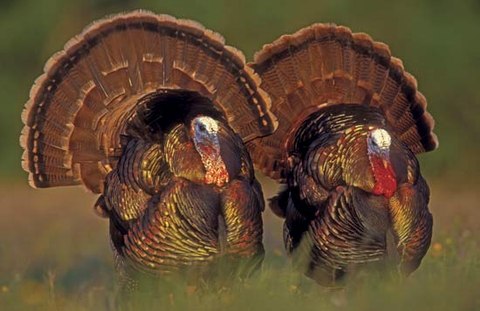Meat chickens
 |
| A layer and a broiler hen, both at 6 weeks of age (c) Coop cam |
Broiler chicken females used for breeding grow very fast. But since fast growth would cause severe injuries and deformations, the females receive only 1/3 of the feed they need. The nearly starving birds are constantly hungry and frustrated. Only because malnutrition their growth slows down, and the birds are able to mate with the roosters and lay fertile eggs.
Broiler chickens meant for meat production (instead of breeding) live only 5-6 weeks before slaughter. During this time the currently used chicken hybrids grow from 40 g to 2,1 - 2,5 kg. In comparison, a layer-breed chicken of 6 weeks of age would weigh less than 800 grams. The temperature of the poultry hall is decreased from 34 C to 20 C as the birds mature. Injured and dead birds are removed from the flock and destroyed. During the rearing time mortality of 3-4 % is expected and accepted. In a flock of 54 000, ~1890 birds will die of various reasons before slaughtering. In Europe, broiler chickens are not medicated in any way. If the hall is disinfected properly between flocks and the rearing conditions are good, the birds stay free from any diseases or parasites, eliminating any need for treatments or preventive medication.
 The rearing is mostly automatized. Ventilation, temperature and humidity control, feeding, watering and light programming are all automated. While it saves work, even relatively short power outages can kill the entire flock to suffocation due to rapidly raising levels of ammonia, H2S and CO2 in the air. Because the light/dark program is carefully designed and obeyed, broiler halls have no windows or any inlet for daylight (organic farms are an exception). Meat chickens are still manually inspected twice a day. The farmer ensures all the automated systems work, and that the litter is dry and clean.
The rearing is mostly automatized. Ventilation, temperature and humidity control, feeding, watering and light programming are all automated. While it saves work, even relatively short power outages can kill the entire flock to suffocation due to rapidly raising levels of ammonia, H2S and CO2 in the air. Because the light/dark program is carefully designed and obeyed, broiler halls have no windows or any inlet for daylight (organic farms are an exception). Meat chickens are still manually inspected twice a day. The farmer ensures all the automated systems work, and that the litter is dry and clean. Meat chickens are fed crumbled feed from the floor during the first two days. The chicks would survive from nutrients in their yolk sacs, but solid feed helps the development of the digestive tract and production of gastric juices. Later the chicks eat granulated feed from feeding cups. Feed and water are freely available, and the height of water nips and feed cups are altered as the birds grow. Feeding is usually phased with four different feed mixes suitable for birds of different ages. Each successive phase has less amino acids, calcium and phosphorus than the previous phase, but the energy content stays at 12,4 MJ/kg ME. This is because the bones of the birds develop fast and need Ca, P and proteins to grow strong. The last phase has no coccidiostates to ensure drug-free meat at slaughter.
 |
| Australian broiler shed. (c) Animals Australia |
Turkey production
 |
| Wild Turkeys (c) Turkey Management |
Turkeys are raised in flocks like meat chickens. During the long rearing time of 3-4 months (compared to the 5-6 weeks of broiler chickens) the turkeys grow to weigh 6-12 kg. Hens and roosters are reared separately because of the size difference. Otherwise they are reared much like meat chickens. Turkeys are, however, much more demanding. They must be given time to develop strong bones at first, so their feed cannot be too strong. Young turkeys must have 8-10 cm of warm, dry and clean litter. The first few days they are kept under a heat lamp in 38 C degrees and in bright lightning. The behaviour of turkey chicks is closely monitored. If they are huddled together, the temperature is too low, or they are stressed. If they are scattered away from the lamps, the temperature is too high.
After the first few days all birds know where to find water and food, so the light intensity can be lowered. Light program is changed gradually to allow for a dark time of 8-10 hours. Humidity is kept at 60-75 %, and by the end of the rearing period the temperature has been decreased to 14-17 C .
Turkeys are fed mostly with complete feeds consisting of wheat, soybeans and peeled oats. Feeding is phased. For example, the recommended phasing for Nicholas-breed turkeys is:
- prestarter (0-2 weeks)
- starter (2-6)
- Grower 1 (6.9)
- Grower 2 (9-12)
- Finisher 1 (12-16)
- Finisher 2 (week 16 onwards)
 |
| Commercial breed turkeys. (c) Zimbio |
Since turkeys are the largest of domesticated birds (not including ostriches or emu), their rearing densities are much lower than that of broilers. At the rearing phase, 3-4 hens or 1 rooster / m2 is used. In farms producing turkey eggs the density is 2 hens or 1 rooster / m2.
No comments:
Post a Comment